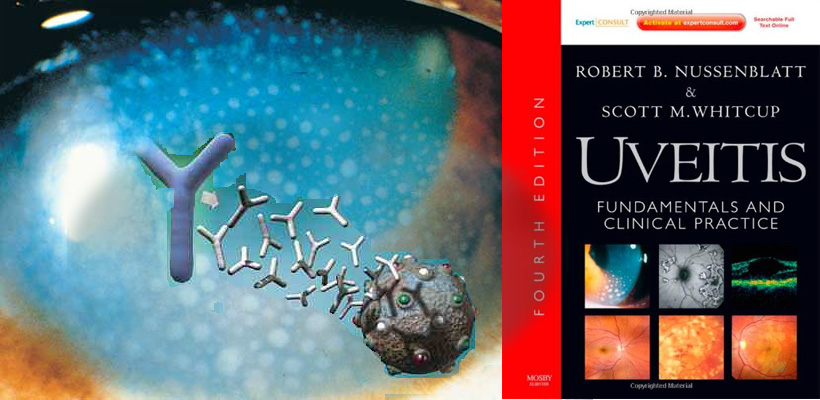Генетическая ДНК диагностика увеита. Гены TNF, MHC1
На данный момент нет уверенных данных в пользу генетической обусловленности увеита. Однако изменения в генах иммунной системы могут вызвать неинфекционные воспалительные реакции, в том числе в глазу (увеит). Увеит может быть проявлением таких системных заболеваний, как анкилозирующий спондиллит, болезнь Бехчета, саркоидоз, токсоплазмоз, герпетическая инфекция.
Завершается набор в клиническое испытание http://clinicaltrials.gov/ct2/show/NCT00874471 для изучения экспрессии генов при системных состояниях, вызывающих увеит (воспаление сосудистой оболочки глаза) , для поиска возможных мутаций. Также в глазном институте Casey проводится клиническое испытания для поиска генов, связанных в появлением увеита. Контактные данные
uveitisg@ohsu.edu Анкета для участия в исследовании.
Толл-подобные рецепторы, как показано, играют важную роль в развитии инфекционного увеита. Белки NOD (Nucleotide Oligomerization Domain) экспрессируемые в цитоплазме антиген-представляющих клеток, узнают продукты жизнедеятельности бактерий и участвуют в развитии увеита. Гены HLA ассоциированы с развитием увеита
- HLA-B27 острый передний увеит
- HLA-B51 болезнь Бехчета
- HLA-A29 мелкоточечная ретинохориопатия
- HLA-DR4 синдром Фогта-Каянаги-Харада
- HLA-DR15 парспланит
- тибулоинтерстициальный нефрит и увеит (TINU)
- саркоидоз
- симпатическая офтальмия
- ювенильный идиопатический артрит.
Показано, что полиморфизм генов, отвечающих за иммунный ответ клетки, может привести к увеитам: гены TNF, MHC класс I полипептид-связанная последовательность A (MICA), интерлейкин-1 (IL-1) и некоторые хемокины. Полиморфизмы в гене CTLA-4, кодирующем костимуляторную молекулу, известную как Т-лимфоцитарный антиген 4, были найдены у китайцев с синдромом Фогта-Каянаги-Харада и отсутствовали при синдроме Бехчета. Вероятно, у человека полиморфизмы генов, опосредованно влияющих на развитие неинфекционного увеита находятся на участках 4q21-31, 5q31-33, 16q22-24, 17p11-q12, 20q11-13 и 22q12-13 хромосом.

Uveitis is defined as an intraocular inflammation induced by different etiologies. Though the precise pathogenesis is still unknown, accumulating evidence shows that both innate and adaptive immune responses may be predominant mechanisms involved in the development of uveitis. Toll-like receptors have been shown to be expressed in the human eye and play an important role in infectious uveitis. The NOD proteins, expressed mainly in the cytosol by APCs, recognize the products of bacteria and participate in the development of uveitis. HLA genes have been associated with some uveitis entities, including acute anterior uveitis (HLA-B27), Behcet disease (HLA-B51), birdshot retinochoroidopathy (HLA-A29), Vogt-Koyanagi-Harada syndrome (HLA-DR4), sarcoidosis, sympathetic ophthalmia, juvenile idiopathic arthritis, tubulointerstitial nephritis and uveitis (TINU) syndrome, and pars planitis (HLA-DR15). The exact mechanism whereby certain HLA genes predispose to a certain uveitis entity has not yet been elucidated. In addition, several studies have demonstrate that polymorphisms in certain immune response genes, such as tumor necrosis factor (TNF), MHC class I polypeptide-related sequence A (MICA), interleukin-1 (IL-1), and some chemokines, may contribute to the development of human uveitis. Polymorphisms in the gene coding for the costimulatory molecule known as cytotoxic T-lymphocyte antigen 4 (CTLA-4) were recently found in Chinese patients with VKH syndrome but not in patients with Behcet disease. Further developments in the unraveling of immune response genes may lead to a better understanding of human uveitis and will hopefully allow the development of novel treatment regimes.
PMID: 19657978
Using the rat model of experimental autoimmune uveitis (EAU), we previously identified three quantitative trait loci (QTL) associated with EAU on rat chromosomes 4, 12, and 10 (Eau1, Eau2, and Eau3). The primary goal of the current study is to delineate additional non-MHC chromosomal regions that control susceptibility to EAU, and to identify any QTLs that overlap with the QTLs of other autoimmune diseases. Using a set of informative microsatellite markers and F(2) generations of resistant and susceptible MHC class II-matched rat strains (F344 and LEW), we have identified several new significant or suggestive QTLs on rat chromosomes 2, 3, 7, 10, and 19 that control susceptibility to EAU. A protective allele was identified in the susceptible LEW strain in the Eau5 locus at D7Wox18, and epistatic interactions between QTLs were found to influence the severity of disease. The newly identified regions (Eau4 through Eau9) colocalize with the genetic determinants of other autoimmune disease models, and to disease-regulating syntenic regions identified in autoimmune patients on human chromosomes 4q21-31, 5q31-33, 16q22-24, 17p11-q12, 20q11-13, and 22q12-13. Our results suggest that uveitis shares some of the pathogenic mechanisms associated with other autoimmune diseases, and lends support to the "common gene, common pathway" hypothesis for autoimmune disorders. PMID: 18453595
http://www.uveitissociety.org (с) Марианна Иванова, август 2012
|